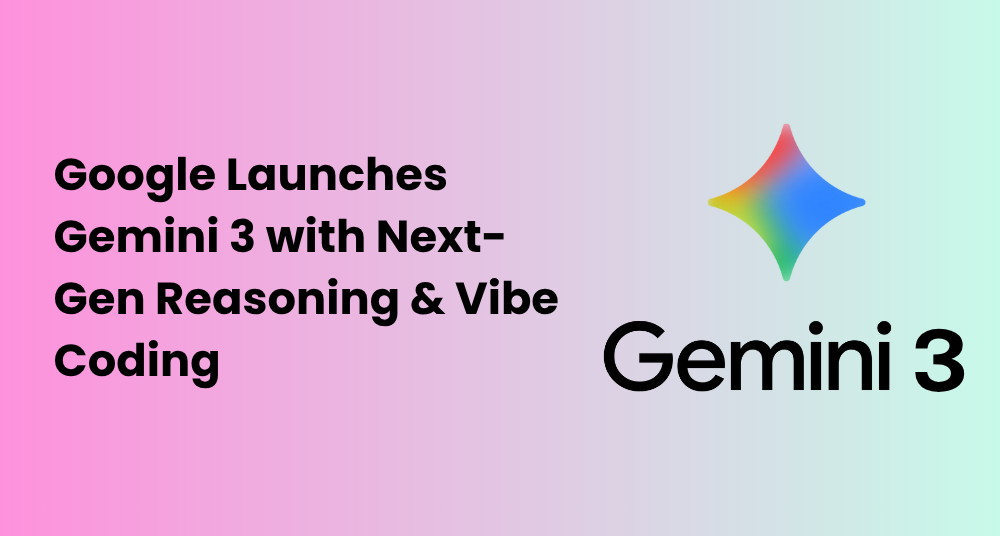Google has just taken a significant leap forward in artificial intelligence with the launch of Gemini 3, a powerful new model that redefines what AI can do — from deep reasoning to next-generation “vibe coding,” multimodal understanding, and agentic workflows. This isn’t just another version of Gemini: Google calls it its “most intelligent model yet,” and it comes with major upgrades across the board.
In this post, we’ll explore what Gemini 3 is, what’s new, how it changes the AI game (especially for developers and enterprises), and the practical use cases you should know about.
What is Gemini 3?
Gemini 3 is the third major generation of Google’s Gemini AI model, built with significant improvements over its predecessors — particularly in reasoning, multimodal understanding, and intelligent coding.
Here are the core things that define Gemini 3:
- Advanced Reasoning: It delivers more depth and nuance in responses — not just surface-level answers, but complex analysis with insight.
- Multimodal Understanding: Gemini 3 can process and reason across text, images, video, audio, and even code.
- Agentic Capabilities: It’s better at performing multi-step, tool-based tasks — not just chat, but doing.
- Vibe Coding: Google highlights Gemini 3’s “vibe coding” as its most powerful coding model — means it can generate code more intuitively based on your style, context, and prompt.
- Enterprise Integration: Gemini 3 is now available in enterprise platforms (Vertex AI, Gemini Enterprise) for businesses.
- DeepThink Version: Google is also working on Gemini 3 Deepthink, a research-focused version for highly complex reasoning, scientific tasks, and algorithmic work.
Key New Features of Gemini 3
Let’s dive deeper into the most notable new capabilities that come with Gemini 3.
Sharper Reasoning & Benchmark Performance
- Google claims a “massive jump in reasoning” with Gemini 3.
- On independent benchmarks, it scores extremely high: for example, on the Humanity’s Last Exam benchmark, Gemini 3 reportedly outperforms even advanced models.
- According to Google DeepMind’s model page, Gemini 3 handles nuanced, multi-layered problems, demonstrates better instruction-following, and uses its context window more effectively.
This means it’s not just better at typical Q&A — it can reason through more complicated scenarios, understand subtleties, and produce more meaningful and accurate responses.
Generative Interfaces: Visual Layout & Dynamic View
One of the most exciting UI-level innovations of Gemini 3 is what Google calls “generative interfaces.” These are not just text responses — Gemini 3 can dynamically generate rich, interactive UIs, tailored to the prompt:
- Visual Layout: When you ask something like “Plan a 3-day trip to Rome,” Gemini 3 can generate a magazine-style itinerary — with images, modular sections, timelines, and more.
- Dynamic View: For more complex queries, Gemini designs and codes a custom interface in real-time — for example, “Explain the Van Gogh gallery with life context” could generate a tappable, scrollable interface that’s built for that content.
This is a big shift — instead of static text, Gemini adapts its output format to suit your question, making things more engaging and useful.
Gemini Agent: Multi-Step Tasks, Automated
Gemini Agent is a built-in tool (powered by Gemini 3) that can take on multi-step, real-world tasks.
Some capabilities:
- It can connect with your Google apps (Calendar, Gmail, etc.) to manage to-dos, reminders, or even draft messages.
- For example: “Help me book a mid-size SUV for my trip next week for under $80/day using details from my email” — Gemini Agent can research, compare, and build an action plan.
- It is designed to ask for your approval on critical actions, so you remain in control.
This is a big step toward more “assistant that acts” rather than just “assistant that suggests.”
Vibe Coding: Smarter, Intuitive Code Generation
Perhaps one of the biggest developer-focused upgrades: vibe coding.
- Google describes Gemini 3 as its most powerful vibe coding model yet.
- In practice, this means Gemini 3 can take multimodal prompts (text, images, instructions) and generate code that feels “on vibe” — matching the style, the UI concept, and functional intent.
- Developers can access Gemini 3 via Google AI Studio, Vertex AI, and more.
- Google also launched Antigravity, a new “agent-first” IDE using Gemini 3, where AI agents can code, test, and manage tasks inside a multi-pane environment (editor, terminal, browser).
This is a paradigm shift: not just AI-assisted coding, but AI agents actively participating in building software.
Enterprise-Grade Model
For businesses, Gemini 3 is now available in Vertex AI and Gemini Enterprise.
This brings:
- State-of-the-art reasoning + multimodality for enterprise use.
- High context window, which helps in understanding longer documents, business data, and multimodal inputs.
- Agentic capabilities to automate tasks, build AI tools, or create intelligent assistants within enterprise workflows.
Security & Robustness
Google emphasizes that Gemini 3 has been designed with safety and misuse-resistance in mind. According to reports:
- Improved resistance against prompt injection (i.e., malicious or adversarial prompts).
- Reduced “sycophancy” — meaning it’s less likely to flatter or echo the user blindly.
- Stronger protections around agentic usage to prevent harmful or unintended behavior.
DeepThink Variant
- Gemini 3 DeepThink is the research-optimized version, aimed at very complex tasks: scientific research, algorithmic development, long-form planning.
- This variant is likely to be used by researchers, scientists, and enterprise users who need step-by-step reasoning and careful deliberation.
How Gemini 3 Is Rolling Out & Where You Can Use It?
Gemini 3 is not just a developer tool — it’s being integrated across Google’s ecosystem:
In the Gemini App
- Available to Google AI subscribers (Pro, Ultra) via “Thinking” model selector.
- New UI: refreshed design, “My Stuff” folder, better browsing, and improved shopping experience via the Shopping Graph.
- Generative interfaces (visual layout, dynamic view) are being rolled out.
In Google Search (AI Mode)
- Gemini 3 powers AI Mode in Google Search for complex queries.
- It can generate interactive tools and simulations inside Search results — like a custom interface or dynamic visualizations based on the prompt.
- This is being rolled out to Google AI Pro and Ultra users first.
For Developers
- Google AI Studio / Vertex AI: Developers can build apps using Gemini 3’s reasoning and code generation.
- Antigravity IDE: As mentioned, a new environment that gives AI agents control over editor, terminal, and browser to code, test, debug.
- Gemini CLI: Gemini 3 is being integrated into the command-line interface so developers can use it directly in their terminal.
Enterprise
Via Gemini Enterprise and Vertex AI, companies can embed Gemini 3 into their internal workflows, build custom AI agents, or use its reasoning for data-rich problems.
Real-World Use Cases for Gemini 3
Here are some compelling use-cases that Gemini 3 unlocks, thanks to its reasoning, multimodal, and agentic capabilities:
Intelligent Personal Assistant
- Use Gemini Agent to manage calendar, inbox, reminders.
- Ask it to plan your travel: Gemini generates trip itinerary, compares hotels, and even suggests day-by-day activities with interactive layout.
Education & Learning
- Provide a lecture video or handwritten notes, and Gemini 3 can translate them, summarize, or turn them into interactive flashcards.
- Use DeepThink for complex academic problems, research proposals, or planning scientific experiments.
Vibe Coding / Development
- Describe your app idea in natural language or via sketches, and Gemini 3 can “vibe-code” the app: generate UI + backend + code structure.
- In Antigravity, have AI agents code parts of your application, debug, and test — reducing manual repetitive tasks.
- Use the CLI to build or debug code directly through terminal prompts.
Business Workflows & Automation
- Enterprises can build AI-powered agents to automate processes: report generation, customer responses, scheduling, or data analysis using Vertex AI.
- Use generative interfaces in Search or in internal tools to build rich dashboards, simulations, or visual reports on the fly.
Creative Content Generation
- Ask Gemini 3 to generate interactive essays, or magazine-style layouts for articles.
- Use images, video, and text together: give Gemini a photo or a sketch, and ask it to build a narrative around it, with interactive components.
Research & Scientific Innovation
- With DeepThink, tackle algorithmic design, optimization problems, or rigorous scientific queries.
- Use its large context window to parse and reason about long technical documents, codebases, or research papers.
Implications & What This Means for the AI Landscape
The release of Gemini 3 is a big deal for several reasons:
- Competition Heats Up: Google is clearly pushing to stay at the forefront of the AI race — reasoning, coding, and agentic ability are key battlegrounds.
- New Paradigm for Coding: With vibe coding and Antigravity, AI is not just assisting — it’s becoming a co-developer. This could massively change how software gets built.
- Enterprise Adoption: By making Gemini 3 available via Vertex AI and Enterprise, Google is enabling businesses to adopt this frontier model safely and at scale.
- Interactive AI Interfaces: The generative interface concept (visual layout, dynamic view) is a step toward AI that generates not just text but meaningful, interactive UIs.
- Safer AI: The emphasis on safety, prompt resistance, and reduced sycophancy signals that Google is serious about building responsible agents.
- Research & Innovation Tool: DeepThink could become a tool for researchers, scientists, and advanced developers to push the boundaries of discovery with AI.
Limitations & Challenges
No model is perfect, and Gemini 3, for all its power, will also face challenges:
- Access Limits: Some features — like Gemini Agent or DeepThink — may roll out gradually or be gated for Ultra / enterprise users.
- Compute Cost: Running large multimodal or agentic tasks may become expensive for users or businesses.
- Safety Risks: While Google emphasizes safety, powerful agentic AI always opens up risks (misuse, over-automation, unintended behaviors).
- Complexity for Developers: New tools like Antigravity require developers to learn new workflows (agent-based coding), which could have a learning curve.
- User Adoption: Interactive generative interfaces are powerful, but users may need time to adapt to them vs traditional chat-based AI.
Final Thought
The launch of Google Gemini 3 is a landmark moment. It’s not just a more powerful chatbot or a better generative model — it’s a reasoning powerhouse, an intuitive coder, and a multimodal agent capable of interacting with you and performing tasks deeply and meaningfully.
From vibe coding to interactive generative interfaces, from multi-step agents to enterprise-ready AI, Gemini 3 brings a new era of AI — one where ideas can be turned into action more naturally, and workflows are simpler, smarter, and more powerful.
For developers, enterprises, creatives, and power users, Gemini 3 is a tool to build, explore, and automate like never before. Its reasoning depth and agentic capabilities could change how we approach problem-solving, software development, and daily AI interactions.
As with any frontier AI, there are challenges — but the potential is enormous. The multimodal, reasoning-rich, agentic future Google envisions with Gemini 3 may well be here, and now is a great time to jump in and experiment.
Related Blog: Google Gemini vs Perplexity AI






What do you think?
It is nice to know your opinion. Leave a comment.